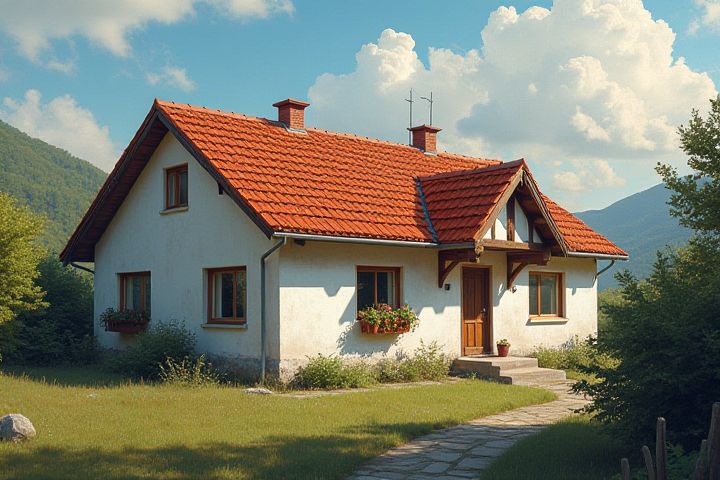
Painting a house roof involves several key steps to ensure durability and aesthetic appeal. First, you must select a high-quality roof paint designed for the material of your roof, whether it's asphalt shingles, metal, or tile. Proper preparation is crucial, so cleaning the roof to remove moss, dirt, and debris will help the paint adhere effectively. Using a roller or spray application, you can evenly apply the paint, ensuring complete coverage while considering weather conditions to avoid rain or strong winds. Remember to prioritize safety by using a harness and taking necessary precautions when working at heights.
Can You Paint A House Roof
Roof type and material
When painting a house roof, it's crucial to consider the type of roof and the material used. Asphalt shingles, a common roofing material, require a product specifically designed for flexibility and UV resistance. Metal roofs, often chosen for their durability, benefit from paints that prevent rust and provide insulation. Your choice of paint should align with the roof type to ensure durability, protect against weather elements, and enhance the overall aesthetic appeal of your home.
Local weather conditions
To effectively paint a house roof, consider the specific local weather conditions, as they play a crucial role in the longevity and appearance of the paint. Ideally, temperatures should be between 50degF (10degC) and 90degF (32degC) for optimal adhesion and drying time. In regions with high humidity, aim to paint on days when the humidity is below 85% to prevent issues like bubbling and peeling. You may also want to monitor the forecast for rain, as applying paint just before wet weather can lead to poor results and necessitate touch-ups, costing you both time and resources.
Paint type and quality
When selecting paint for your house roof, consider using high-quality acrylic latex paints that offer durability and weather resistance. These paints typically have a lifespan of 10-15 years and provide excellent adhesion and flexibility, preventing cracking under extreme temperatures. Look for products with reflective qualities that can lower rooftop temperatures by up to 20%, improving energy efficiency and reducing cooling costs. Ensure the paint is mildew-resistant, as roofs are often exposed to moisture, and choosing a paint with a low VOC (volatile organic compounds) content contributes to a healthier environment for both you and your surroundings.
Safety precautions
When painting a house roof, prioritizing safety is essential to prevent accidents. Use a sturdy ladder rated for at least 300 pounds and ensure it's placed on a flat surface to avoid slips. Wear non-slip footwear and a safety harness, especially if the roof pitch exceeds 4:12, to secure yourself while working at height. Always check the weather forecast to avoid painting during rain or high winds, which can increase the risk of falls.
Proper surface preparation
Proper surface preparation is crucial for a successful roof painting project. Begin by conducting a thorough inspection of your roof, ensuring that it is clean and free from debris, dirt, or moss buildup. Use a pressure washer to remove any loose materials, and repair any damaged areas, such as cracks or missing shingles, to create a smooth, even surface. Once prepped, apply a high-quality primer designed for roofing materials to enhance adhesion and durability, ensuring your paint lasts for years to come.
Necessary permits/regulations
When painting a house roof, it is essential to check local building codes and obtain the necessary permits to ensure compliance. Each municipality may have specific regulations regarding roofing materials and colors, which you should follow to avoid fines and ensure the longevity of your project. Before beginning, consult your homeowner's association or local zoning board for guidelines, as they might have restrictions on aesthetic modifications in your neighborhood. Ignoring these regulations can lead to costly setbacks or the requirement to revert to the original condition.
Appropriate tools and equipment
To paint a house roof effectively, you will need a variety of appropriate tools and equipment. A high-quality paint roller with an extended handle is essential for reaching higher areas without strain. Safety gear, including a sturdy ladder, harness, and slip-resistant shoes, ensures your well-being while working at height. Finally, a waterproof tarp can protect the surrounding area from paint splatter, ensuring a clean and professional finish.
Painting technique and method
To successfully paint a house roof, first prepare the surface by cleaning it thoroughly to remove dirt, moss, and old paint. Choose a high-quality, weather-resistant roof paint, ideally designed for the specific material of your roof, whether it be asphalt shingles, metal, or tiles. Employing a spray gun or roller will ensure a smooth, even application, but a brush can be useful for detailed areas and edges. Always work from the top down to prevent drips and ensure optimal coverage, and consider painting on a dry day to allow for proper drying and adhesion.
Maintenance and longevity
Choosing the right paint for your house roof is crucial for ensuring its maintenance and longevity. High-quality, UV-resistant coatings can prevent fading and deterioration, extending the lifespan of your roof by up to 20 years. Regular inspections and touch-ups can save you from costly repairs, as a well-maintained roof can withstand harsh weather conditions, including heavy rain and extreme temperatures. By investing in durable roofing paint and adhering to a routine maintenance schedule, you safeguard your home and enhance its overall value, protecting your investment for years to come.
Cost estimation and budget
Estimating the cost of painting a house roof involves several factors, including the type of roofing materials, the size of the roof, and the quality of paint chosen. You should also consider labor costs, which can vary depending on the complexity of the roof's design and the experience of the contractors. On average, homeowners can expect to spend between $1 to $3 per square foot for the job, while high-quality coatings may increase costs. Creating a budget that includes preparation, materials, labor, and potential contingencies will help ensure your project stays on track financially.
